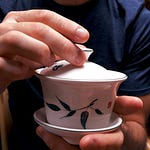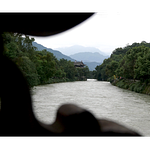This is part two of a two-part adventure into the world of tea. Listen to part one here.
“The Chinese character for tea, 茶chá * has three components,” says周丽萍Zhōu Lì Píng as she glides her horsehair calligraphy brush across the page. 草Cǎo (grass); 人 rén (people) and 木mù (wood). When tea was discovered, humans were surrounded by grass and woods; they were much closer to Nature than we are today. So when we drink tea, we can taste and feel nature.”
We’re in a traditional teahouse in the South of Chéngdū, where Lì Píng, our Chinese teacher, has invited us on a journey of investigation into the earliest origins of tea culture. While we learnt much about the interconnected nature of Chinese and British history from a recent visit to a more laid-back teahouse, I suspect we’ve barely scratched the surface.
“The legend of tea dates back four and a half thousand years,” Lì Píng says, opening a small bag of dark leaves and pouring them into a lidded cup. “The Divine Farmer 神农 Shénnóng was trying different medicinal herbs in the forest when some tea leaves blew into his cooking pot. After that, tea was adopted by Chinese people as a medicine, food and drink.”
With the practiced mindfulness of any good host, Lì Píng begins the careful transfer of near-boiling water between cherished utensils, a process that makes up the Chinese tea ceremony. It is likely that this ritual has its earliest roots in the ancient meditation practices of monks and shamans, who used caffeine to explore altered states of consciousness.
While it has been through many stages of evolution since Shénnóng‘a experience in the forest, it wasn’t until the Tang dynasty (618-906 AD). that tea was truly ‘emancipated from its crude state’ (Kazuko, 1910) into a more refined and widespread art. The Tang was a cultural golden age, in which三教sānjiào, the ‘Three Religions’ of Daoism, Buddhism and Confucianism, all embraced ritualised tea drinking.
“That was a great time to be a Buddhist,” Lì Píng says with a chuckle. “The government would pay people to live in a temple and spend their days meditating and drinking tea… Much easier than working in a field!”
Following her instructions to keep the tea on our tongues for several seconds, all the while maintaining a “pleasant facial expression” for etiquette, we observe the tea’s flavours as they shift and evolve: fruity, slightly smoky and then sweet, with only the faintest tannin bitterness. People train their palates for a lifetime to discern such flavours, but I’m certain it’s the subsequent feeling of focus and euphoria that led Tang poets to believe tea possessed the elixir of immortality. I’d go as far as to wager that 盧仝LúTóng was severely caffeinated when he wrote the poem七碗茶 QīWǎnChá, Seven Bowls of Tea, as it reads like a Tang dynasty version of ‘Red Bull Gives You Wings!’
…The fourth bowl raises a slight perspiration
And all life’s inequities pass out through my pores
The fifth bowl purifies my flesh and bones
The sixth bowl calls me to the immortals
The seventh bowl couldn’t be drunk
The breath of the cool wind brushes my sleeve
Where is Penglai Island, Land of Immortals?
(I) wish to fly there, riding this sweet breeze.
This is matched by the prose of 陆羽 LùYǔ, China’s original ‘Tea Saint’ and the true ‘Elvis … to the popularity of tea in Chinese Society’ (Montgomery 2020). His tea encyclopedia the茶经 Chájīng, ‘Classic of Tea,’ is so luxuriant in detail that it radiates something akin to love:
(The best tea leaves must) curl like the dewlap of a mighty bullock, unfold like a mist rising out of a ravine, gleam like a lake touched by a zephyr, and be wet and soft like fine earth newly swept by rain.
Time flies and conversation flows as Lì Píng diligently refills our cups again and again. The tea leaves gradually get weaker, until what we’re drinking is little more than lightly-scented hot water. Under more formal circumstances, to drink beyond this point would be to overstay one’s welcome. But among friends, wringing every last drop of flavour from the leaves is a sign of familiarity and good关系 guānxi. It’s in this friendly atmosphere that Tamzin jokingly asks:
“Have you ever tried English tea?”
Lì Píng thinks for a second or two, then laughs.
“You mean, in the bag? Actually, yes I have. A British friend invited me to try it a while ago, with milk… I’m sorry, but that wasn’t tea.”
Say no more, I think. The taste, feeling and overall experience of Chinese chá is so unlike anything I’ve experienced in the UK that it’s hard to believe it belongs to the same plant.
This realization reminds me of a bizarre and cringe-worthy 2014 video that’s recently gone viral, of UK Conservative Party leadership candidate Liz Truss addressing the Party Conference on her ideal vision of Britain-led food system. In a spiel that manages to be both eerily robotic and dripping in what Naomi Klein would term ‘toxic nostalgia,’ Truss exclaims: “We are selling tea to China!Yorkshire Tea!”
I hope Lì Píng never sees this clip, as it’s embarrassing on two levels. Firstly, (so-called) Yorkshire Tea is only bought in China by homesick Brits: no sane Chinese person would pay import tax on weird, foreign teabags when they have the real thing at home.
Secondly, Truss’s thinly-veiled nod to Britain’s imperial rivalry with China over the tea trade is both worrying and misplaced. Britain’s extensive tea colonies in India and Ceylon left a legacy of exploitation that endures to this day. However, China’s ‘much larger and more developed market economies and tea cultures’ (Rappaport, 2017) both predated and outlived the British Empire.
Under tea’s spell, it seems we’ve unintentionally performed the Daoist practice of做忘zuòwàng – to sit and forget – ignoring our own stomachs in the process. Four hours have passed and I’m seriously hungry.
As we leave in search of food I reflect that if we are ever going to achieve a level of cooperation and mutual understanding with China that is capable of tackling the intersecting crises that threaten us as a species, we first need to do away with outdated, imperialist views of history. At the same time, the tea session we have shared has given me an increased sense of connection, both with the people of China and with nature, all via a humble plant that has reshaped world history.
Thanks for reading! We hope you enjoyed this two-part foray into the world of tea. Stay tuned for our video coming soon, in which we take you along on our tea-themed adventure!
* The English word ‘tea’ is thought to be derived from福州话 Fúzhōuhuà, a dialect of the coastal region of福建Fújiàn, where British and Dutch traders first encountered the plant.
Sources:
- Juenong W (2005) An Illustrated Reader of The Classic of Tea (trans. Tony Blishen), Shanghai Press
- Kakuzo O (1906) The Book of Tea, Digreads.com
- Montgomery, L (2021) The Tea History Podcast, Ep. 4: The Sage of Tea: Lu Yu, Teacup Media
- Rappaport E (2017) A Thirst For Empire: How Tea Shaped the Modern World, Princeton University Press












